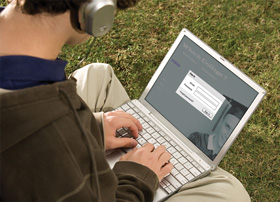Is the only thing protecting your bank account, credit card and personal emails an easy-to-crack password? If so, you’re not alone. It seems like we need passwords for everything these days—to shop, bank, communicate and share online—so it’s tempting to pick something simple and easy to remember.
But choosing a password that includes your dog’s name or your birthday can be a big mistake. Cybercriminals are devious and they can crack your passwords using a variety of methods, from making educated guesses based on the information you share online, to using computer programs that can help them search possible word and number combinations.

While it may be okay to use a generic, easy-to-remember password for sites that don’t hold any sensitive information, when it comes to online banking, shopping, email and social networking sites, you need to take some extra time to create strong passwords that keep crooks far away from your personally identifiable information.
Even the challenge, or security questions, that sites ask if you forget your password often use information that can be easily guessed. Security questions such as “What’s your pet’s name?” or “What city were you born in?” can often be answered with information from your social networking profile, or other sites where you share personal information.
So, the best defense against cybercriminals is a strong password that is easy to remember but hard to guess. Here are a few expert tips to help you create a strong password, and keep it safe.
Do:
•Choose a password that is at least 8 characters long
•Include both lowercase letters and uppercase letters
•Include numbers and symbols, such as a 5, 3, $, !, or #
Don't:
•Use personal information, such as your name, address, pet’s name or favorite song
•Use dictionary words, slang, or common misspellings
•Use more than three consecutive characters of one type, such as 123 or xyz
•Use the same password for sites that hold sensitive information, like banking and
shopping sites
Now that you know how to create a strong password, make it memorable. One good idea is to take a common saying and turn it in to a clever password combination. For instance, “To be or not to be” can become “2B-or-Not_2b?”. Or, create a password by looking at your keyboard and tracing a shape on the keys. So, by making an “M” shape starting from the “A” key, you get “AW3$R%TH.” It may look hard to remember, but when you think of the shape on the keyboard, you can type it out easily.
Once you have a strong password, keep it safe. Don’t share your passwords, even with close friends, and make sure to change your passwords periodically. If you write down your password, don’t keep it close to your computer, and disguise it by adding other letters and numbers around it. Finally, make sure that you have comprehensive security software, such as McAfee Total Protection™ software, that can help safeguard you from malware such as keystroke loggers, which can secretly record your passwords as you type them.
Orginal Article:
http://home.mcafee.com/AdviceCenter/Default.aspx?id=rs_na_su11article1 Total Members: 14197
Total Members: 14197 Latest: Levine
Latest: Levine Total Posts: 43441
Total Posts: 43441 Total Topics: 16533
Total Topics: 16533 Online today: 3143
Online today: 3143 Online ever: 51419
Online ever: 51419 Total Members: 14197
Total Members: 14197 Latest: Levine
Latest: Levine Total Posts: 43441
Total Posts: 43441 Total Topics: 16533
Total Topics: 16533 Online today: 3143
Online today: 3143 Online ever: 51419
Online ever: 51419